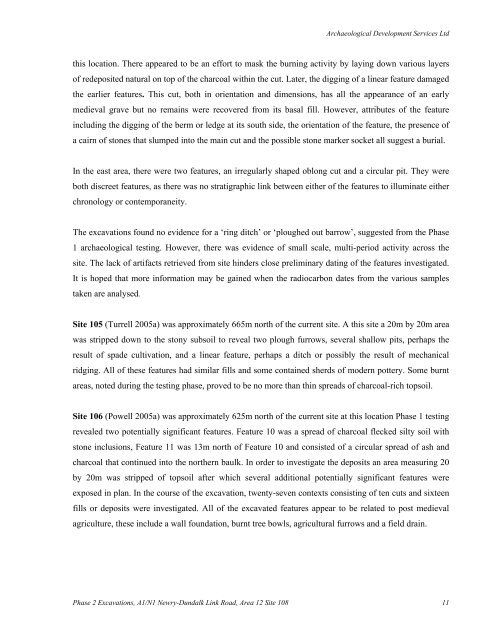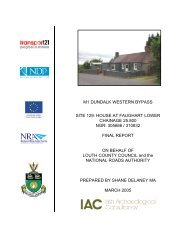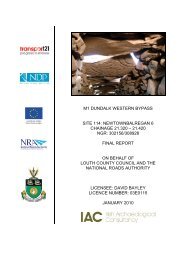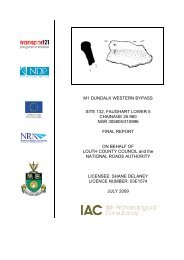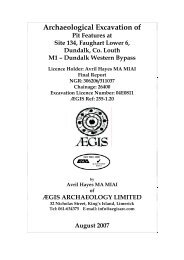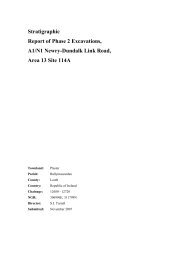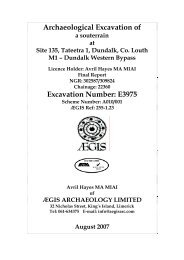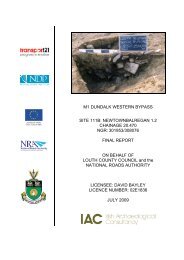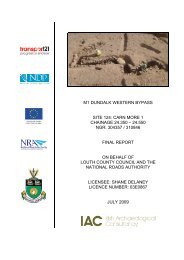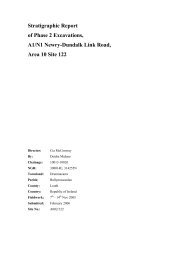Aghnaskeagh 1 Interim Report - ASI Louth
Aghnaskeagh 1 Interim Report - ASI Louth
Aghnaskeagh 1 Interim Report - ASI Louth
You also want an ePaper? Increase the reach of your titles
YUMPU automatically turns print PDFs into web optimized ePapers that Google loves.
Archaeological Development Services Ltd<br />
this location. There appeared to be an effort to mask the burning activity by laying down various layers<br />
of redeposited natural on top of the charcoal within the cut. Later, the digging of a linear feature damaged<br />
the earlier features. This cut, both in orientation and dimensions, has all the appearance of an early<br />
medieval grave but no remains were recovered from its basal fill. However, attributes of the feature<br />
including the digging of the berm or ledge at its south side, the orientation of the feature, the presence of<br />
a cairn of stones that slumped into the main cut and the possible stone marker socket all suggest a burial.<br />
In the east area, there were two features, an irregularly shaped oblong cut and a circular pit. They were<br />
both discreet features, as there was no stratigraphic link between either of the features to illuminate either<br />
chronology or contemporaneity.<br />
The excavations found no evidence for a ‘ring ditch’ or ‘ploughed out barrow’, suggested from the Phase<br />
1 archaeological testing. However, there was evidence of small scale, multi-period activity across the<br />
site. The lack of artifacts retrieved from site hinders close preliminary dating of the features investigated.<br />
It is hoped that more information may be gained when the radiocarbon dates from the various samples<br />
taken are analysed.<br />
Site 105 (Turrell 2005a) was approximately 665m north of the current site. A this site a 20m by 20m area<br />
was stripped down to the stony subsoil to reveal two plough furrows, several shallow pits, perhaps the<br />
result of spade cultivation, and a linear feature, perhaps a ditch or possibly the result of mechanical<br />
ridging. All of these features had similar fills and some contained sherds of modern pottery. Some burnt<br />
areas, noted during the testing phase, proved to be no more than thin spreads of charcoal-rich topsoil.<br />
Site 106 (Powell 2005a) was approximately 625m north of the current site at this location Phase 1 testing<br />
revealed two potentially significant features. Feature 10 was a spread of charcoal flecked silty soil with<br />
stone inclusions, Feature 11 was 13m north of Feature 10 and consisted of a circular spread of ash and<br />
charcoal that continued into the northern baulk. In order to investigate the deposits an area measuring 20<br />
by 20m was stripped of topsoil after which several additional potentially significant features were<br />
exposed in plan. In the course of the excavation, twenty-seven contexts consisting of ten cuts and sixteen<br />
fills or deposits were investigated. All of the excavated features appear to be related to post medieval<br />
agriculture, these include a wall foundation, burnt tree bowls, agricultural furrows and a field drain.<br />
Phase 2 Excavations, A1/N1 Newry-Dundalk Link Road, Area 12 Site 108 11


